
The viviparous eelpout, also known as the, viviparous blenny and European eelpout is species of marine ray-finned fish belonging to the family Zoarcidae, the eelpouts. It is notable for being ovoviviparous and gives birth to live larvae. It is a common soup ingredient in Mediterranean countries. The bones are of greenish colour, due to a harmless pigment. Their skin is slimy and the colour is variable.

The haddock is a saltwater ray-finned fish from the family Gadidae, the true cods. It is the only species in the monotypic genus Melanogrammus. It is found in the North Atlantic Ocean and associated seas, where it is an important species for fisheries, especially in northern Europe, where it is marketed fresh, frozen and smoked; smoked varieties include the Finnan haddie and the Arbroath smokie.

The Atlantic wolffish, also known as the seawolf, Atlantic catfish, ocean catfish, devil fish, wolf eel, woof or sea cat, is a marine fish of the wolffish family Anarhichadidae, native to the North Atlantic Ocean. The numbers of the Atlantic wolffish in US waters are rapidly being depleted, most likely due to overfishing and bycatch, and it is currently a Species of Concern according to the U.S. National Oceanic and Atmospheric Administration's National Marine Fisheries Service.
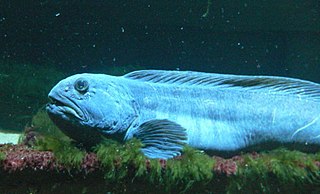
Anarhichadidae, the wolffishes, sea wolves or wolf eels, is a family of marine ray finned fishes belonging to the order Scorpaeniformes. These are predatory, eel shaped fishes which are native to the cold waters of the Arctic, North Pacific and North Atlantic Oceans.

Cyclopterus is a genus of marine ray-finned fish belonging to the family Cyclopteridae, the lumpsuckers or lumpfish. Its only species is Cyclopterus lumpus, the lumpsucker or lumpfish. It is found in the North Atlantic and adjacent parts of the Arctic Ocean, ranging as far south as Chesapeake Bay on the North American coast and Spain on the European coast. The species has been reported twice in the Mediterranean Sea, off Croatia in 2004 and Cyprus in 2017.
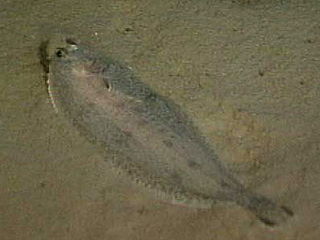
The witch, known in English by a variety of other common names including the witch flounder, pole flounder, craig fluke, Torbay sole, and grey sole, is a species of flatfish from the family Pleuronectidae. It occurs on both sides of the North Atlantic Ocean on muddy sea beds in quite deep water. In northern Europe it has some importance in fisheries as a food fish.
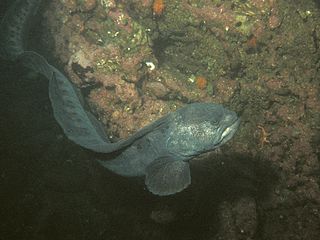
The wolf eel is a species of marine ray-finned fish belonging to the family Anarhichadidae, the wolf fishes. It is found in the North Pacific Ocean. Despite its common name and resemblance, it is not a true eel. It is the only species in the monotypic genus Anarrhichthys.

The northern wolffish, also known as the blue sea cat or jelly cat, is a species of marine ray-finned fish belonging to the family Anarhichadidae, the wolf fishes. This species is found in the North Atlantic Ocean and Arctic Ocean.

Anarhichas is a genus of marine ray-finned fishes belonging to the family Anarhichadidae, the wolffishes or sea wolves. These fishes are found in the northern North Atlantic and North Pacific oceans.

Prionotus carolinus, the northern sea robin, is a species of marine ray-finned fish belonging to the family Triglidae, the sea robins. This fish is found in the western Atlantic Ocean.

Liparis liparis, the common seasnail, striped seasnail or seasnail, is a small species of marine ray-finned fish belonging to the family Liparidae, the snailfishes, in the order Scorpaeniformes, the scorpionfishes and flatheads. It is found in the northeastern Atlantic Ocean where it lives on the seabed.

Anarhichas orientalis, the Bering wolffish, is a marine fish in the family Anarhichadidae, the "wolffish".
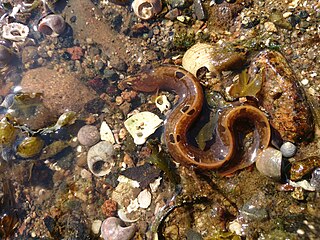
The rock gunnel, or butterfish, is a species of marine ray-finned fish belonging to the family Pholidae, the gunnels. This species is found in the coastal waters of the North Atlantic Ocean and in the Atlantic part of the Arctic Ocean.
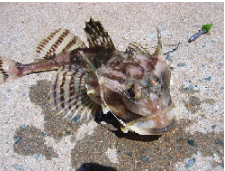
Artediellus atlanticus, the Atlantic hookear sculpin or hookhorn sculpin, is a species of marine ray-finned fish belonging to the family Cottidae. This species is found along the coasts of Northern Atlantic Ocean.

Pholis is a genus of marine ray-finned fish belonging to the family Pholidae, the gunnels. These fishes are found in shallow coastal waters of the North Pacific, Arctic and North Atlantic Oceans.

Stichaeinae is a subfamily of marine ray-finned fishes, classified within the family Stichaeidae, the pricklebacks or shannies. These fishes are found in the North Pacific, Arctic and North Atlantic Oceans.

The Arctic shanny is a species of marine ray-finned fish belonging to the family Stichaeidae, the pricklebacks and shannies. This species occurs in the North Pacific, Arctic and western North Atlantic Oceans.
Lycodes gracilis, Vahl's eelpout or the gracile eelpout, is a species of marine ray-finned fish belonging to the family Zoarcidae, the eelpouts. It is found in the eastern North Atlantic Ocean and adjacent areas of the Arctic Ocean.
Lycodes esmarkii, Esmark's eelpout or the greater eelpout, is a species of marine ray-finned fish belonging to the family Zoarcidae, the eelpouts. This species is found in the North Atlantic Ocean.

The Arctic staghorn sculpin is a species of marine ray-finned fish belonging to the family Cottidae, the typical sculpins. This sculpin is found in the Arctic Ocean and the northern Atlantic Ocean.



















